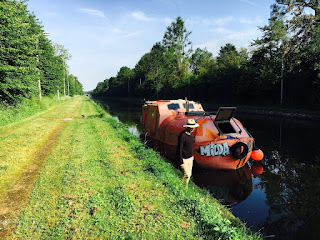Calais to (almost) Paris
A couple weeks after our channel crossing we finally set out to Paris. The plan is to reach Paris in a month as Ana has to be back in London. We set off from Calais around 12pm on the 1st of July 2016 and we get stuck right on the first lock. Lunch time (we learn locks do close for lunch, usually between 12-2pm). We wait. As around 2.30pm no one arrives we call the number written on a little paper left on the door. The lock-keeper will arrive shortly, if now one had called him, he would simply not show up. This will be our assigned lock-keeper for the next few locks, running on his bike along the canal with us.
The Canal Nord de Calais is a narrow canal, slightly same with as the River Lee in London and takes us along abandoned factories, a few refurbished wharehouses, but mostly big cropped fields, empty little villages and not one single boat. It's noticeable that this canal was in the past busy with barges, as we pass lots of rusty metal cranes used in the past to load up barges, but now the boats have been replaced by either trains or trucks and these structures are left as a memory, along the canal, one after the other.
1 lock and 4 mobile bridges later, we turn South to Canal de Neuffose. This is a much wider stretch of water than what we are used to, and looks more like a river than a canal to our English standards. Boats are much bigger here as well we soon realise. The 'Peniches', the traditional French inland barge originally built in the 19th century, with 89m long do scare us a bit when we first cross them, after all we are only 7m long.. the wash is quite something and pulls us to the sides if we're not careful. This is a very green canal, the cropped fields give way to long corridors of trees and we find a few WWII bunkers on the way that we stop and visit, small villages and very big locks!
In Betune, the Canal de Neuffose turns into Canal d'Aire, followed by Canal de Derivation de La Scarpe and Canal de la Sensée. The different canals follow each other almost without us noticing. The only thing that changes is the way the locks open, either with a lock-keeper, with a command, ropes in the middle of the Canal that open the lock ahead when twisted or elevator bollards on the bigger locks.
On this main route to Paris from the big Port of Dunkirk, we decide to turn East along the Canal de la Sensée and South along the Canal de l'Escaut that turns into Canal de Saint-Quentin in Cambrai, instead of continuing South along the busy Canal du Nord. This alternate route will be a bit longer but much more relaxed and picturesque we are told and will take us along the green valleys of the Champagne region and the beautiful towns of Saint-Quentin, Reims, Chateau-Thierry or Meaux.
In Épernay the Canal turns into the Marne river that will take us to Paris. It's amazing how different it is to cruise on a river, one can feel how alive it is, and the current makes us run faster. We get to 10km/h in some stretches. Mooring is more challenging now and right on our first stop, Hamish jumps out to get the ropes and suddenly the current takes 'Milda' away and Ana is left on her own on the big river for a bit. First time alone on the boat and it had to be on a river with a strong current. Hamish shouts instructions, a bit of panic but we make it, Hamish back on board and off to the next stop.
Ana makes it back to London, almost in Paris, and Hamish heads to the big city and the infamous Loire River in his own, until we meet again in a french canal to be decided.
We still haven't filled up with diesel since England and Hamish is on a mission for the next few days of getting some as we believe we must be close to an empty tank.













Comments
Post a Comment